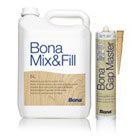Back to DIY Advice
Gap Filling With Mastic Filler
Gap filling usually takes place as a part of the wood floor restoration process. With time and due to the natural expansion and contraction of the timber, gaps may start appearing between the planks of your wooden floor. Sometimes those gaps are very tiny and only a minor effort is enough to fill them.
About gap filling
There are several ways to fill the gaps in a wooden floor. The most popular method by far is by mixing a filler resin with sawdust. This technique allows the filler to acquire the natural colour of the surface upon which it is applied and is used mostly for smaller gaps.
Another option is to use PVA glue instead of resin but the results are arguably not as satisfying. The resin seems superior in some ways is this is the reason for its popularity.
The third method involves using glued wood slivers for larger gaps. Unfortunately, the slivers often limit the natural movement of the floor and tend to split from time to time.
There is also the Papier-mache but this alternative requires a lot of attention to pull off properly and is not very efficient. Finally, we have the flooring filler and the decorator's caulk. These are flexible materials which limit the movement of the floor yet allow it some degree of freedom. One of the main advantages they bring is the possibility to use them on boards with no tongues or grooves.
About Bona Gap Master Filler

Bona gap master filler is a silicone-free adhesive that can be used for minor repairs and gap filling. The product is manufactured in fourteen different colours, so finding a good match for your floor is perfectly possible.
Bona gap master filler is rather expensive but it can bring a lot to the table. The main benefits of the filler are that it is flexible with a 7% expansion rate and is odour-free. The drying time is 18 – 24 hours, which means floor sanding can take place in a minimum of 18 hours after the Bona gap master filler has been applied but the full hardness is achieved only after two to three days.
As good as Bona gap master is, it has its limitations. The drying time may also substantially increase the duration of the floor restoration process. This filler is most often used for the final touch, cracks and filling around the beading and skirting and is not suitable for end-grain floors or gaps within planks.
Please note that wood is a natural material and it expands and contracts constantly. Our experts can refit the floorboards and nail down the loose ones to limit their natural movement. However, no floor sanding company can guarantee the gap filling performed on your floor during the floor restoration process will hold.